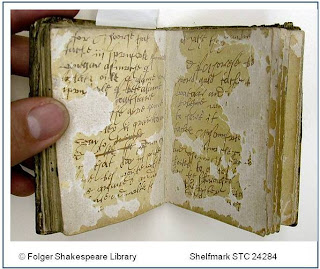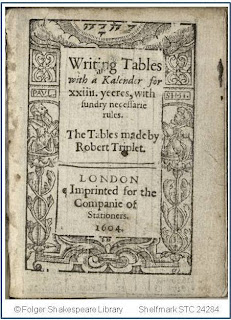In my last post, I mentioned Hamlet’s practice of commonplacing, or recording things of note in his writing tablets. I want to return to Hamlet to look at commonplacing from a slightly different angle–not what is written, but what is written upon.
Below is the first part of the speech from which I quoted before. For context, you should know that Hamlet is speaking to himself after his first encounter with his father’s ghost and during which the ghost exhorted Hamlet to “Remember me.”
Remember thee?
Ay, thou poor ghost, whiles memory holds a seat
In this distracted globe. Remember thee?
Yea, from the table of my memory
I’ll wipe away all trivial fond records,
All saws of books, all forms, all pressures past,
That youth and observation copied there
And thy commandment all alone shall live
Within the book and volume of my brain
Unmixed with baser matter. . . . .
(Hamlet, Arden3, 1.5.95-104)
Hamlet’s description of wiping away the records to clear the space for the commandment to remember his father has long been read as metaphorical. And there is much in the speech that invites us to read it as a metaphor: Hamlet describes his brain as a book wherein memory inscribes itself.
But Hamlet’s reference to writing tables that can be erased is also quite literal. In a marvellous essay in Shakespeare Quarterly is a full account of how erasable tablets were made, who used them, and where we can find surviving examples. One survivor is in the Folger’s collection, a copy of Robert Triplet’s Writing Tables with a Kalender for xxiiii. yeeres (London, 1604). Below is an image of that volume held open to a set of pages treated to be erasable.

The pages were treated with a coating of gesso and glue, and written on with a metal stylus. In this example, you can see how the coating has crumbled over the years, with the top, harder layer remaining in some places (revealing a recipe for treating horses), while along the edges, the under, spongier layer is now visible.
It is worth noting, too, the size of the tables: small, and easily portable. What else makes this a portable tablet, as opposed to other, non-portable writing surfaces? Writing with quill and ink requires many more tools: quill, inkpot, a hard surface, paper, a quill knife, perhaps some blotting material. How could Hamlet–or an actor playing Hamlet–possibly carry so much equipment and stop to write with it? The only other tool required for these tablets is a stylus, and many surviving examples of the tables have evidence of a stylus having been attached directly to them, or kept within the binding.
Once again, the
technologies of writing and the materiality of text shape what we can create. With erasable tablets, a scholar could note in his tables whatever he or she wanted to include in a commonplace book, transfer those notes to the book, and then wipe clear the table to be used again. Hamlet’s juxtaposition of the table able to be wiped clean and the “book and volume of my brain” in which the Ghost’s commandment will be inscribed enacts the practice of commonplacing that we have been considering.
For more information on erasable tablets, see Peter Stallybrass, Roger Chartier, J. Franklin Mowery, and Heather Wolfe, “Hamlet’s Tables and the Technologies of Writing in Renaissance England, ” Shakespeare Quarterly, 55 (2004): 379-419.

